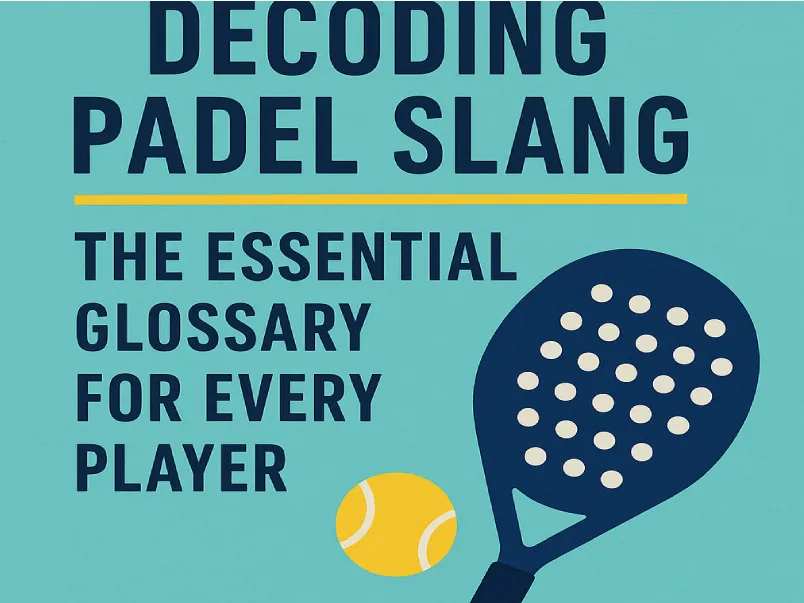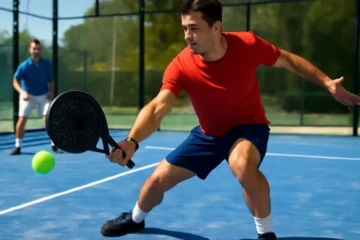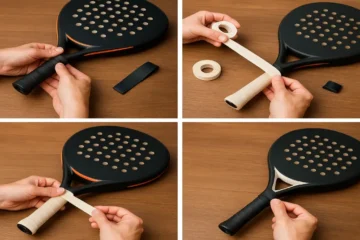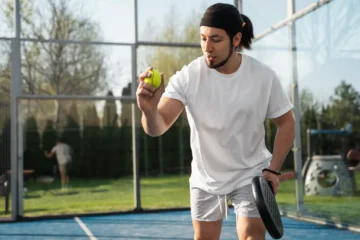You’ve just joined a padel game. Your partner hits a tricky shot and yells, “¡Déjalo!” You stand frozen. Was that for you? Was it a warning?
If you’ve recently taken up padel, this situation might sound all too familiar. As exciting as the sport is, it comes with its own set of rules, tactics, and, of course, language. Understanding the jargon is not only crucial for improving your game, but it also helps you communicate effectively with your partner and immerse yourself in the vibrant padel community.
In this article, we’ll decode the essential padel slang that will help you play better, strategize smarter, and sound like a true padel pro. From the basic commands to advanced trick shots, this guide covers everything you need to know. Whether you’re a novice or a seasoned player, understanding this vocabulary will take your game to the next level.
Part 1: The Fundamentals – Basic On-Court Communication
The foundation of any successful padel partnership lies in effective communication. Padel, like many other sports, requires players to coordinate their movements, anticipate each other’s actions, and call out certain terms to avoid confusion and improve strategy.
Key Terms:
- Mío / Mía / Tuya / Déjalo
These four words form the heart of padel communication. “Mío” (mine) and “Mía” are essential for calling the ball when it’s coming towards you. If you shout “Mío,” your partner knows that you’re taking the shot and they should not interfere.
“Tuya” (yours) is used to indicate that the ball is for your partner. It’s a simple but crucial way to avoid collisions and confusion on the court.
“Déjalo” (Leave it!) is an essential command, especially when the ball is heading toward the glass wall. Shouting “Déjalo” signals that the ball is going to bounce off the wall and your partner should let it pass without trying to play it. - ¡Saca! / A mi
These are simple commands, but they are critical to maintaining the flow of the game. “¡Saca!” is the call for “Serve!” when you’re ready to receive the ball.
“A mi” (To me) is a call made when you’re ready to receive the serve. It tells your partner to let the ball come to you. - La pared / El cristal
These two words refer to the walls in padel. “La pared” (the wall) typically refers to the solid walls that are part of the court. “El cristal” (the glass) is used when referring to the glass walls. Knowing the terminology for the court itself is fundamental, especially when playing against the wall or using the glass to your advantage.
Part 2: Shot Terminology – Naming Your Weapons
Padel offers a variety of shots that require skill and precision. To describe your shots or those of your opponent, you’ll need to know the right terminology.
Key Terms:
- Bandeja (“Tray”)
The bandeja is the signature defensive volley in padel. Played with a high, controlled swing, it’s used to keep the ball in the air and avoid the opponent’s reach while maintaining offensive pressure. It’s the go-to shot when you’re forced to defend near the net. - Víbora (“Viper”)
The víbora is an aggressive variation of the bandeja. With added spin and speed, the víbora puts pressure on your opponents by forcing them to react quickly. It’s a great offensive shot that can surprise opponents and catch them off guard. - Gancho (“Hook”)
The gancho is the padel equivalent of a tennis smash. Played overhead, it’s a powerful shot aimed at the opponent’s side of the court. It can be hit at various angles and is perfect for finishing off a point when the ball is high in the air. - Chiquita (“The little one”)
The chiquita is a soft, delicate drop shot that’s designed to land just past the net and die quickly after hitting the glass. It’s a great technique for breaking up rallies and forcing your opponents to scramble. - Bajada (“Down the line”)
A powerful shot aimed down the sideline, often after a lob. The bajada puts pressure on your opponent by forcing them to cover a lot of ground and react quickly.
Part 3: Advanced & Creative Shots – The Flashy Vocabulary
As you advance in padel, you’ll start to encounter trick shots that are as flashy to execute as they are to say. These advanced shots not only impress the crowd but can also leave your opponents with no chance to return the ball.
Key Terms:
- Globo (“Lob”)
The globo is a high, defensive shot that pushes your opponents back from the net, giving you more time to reposition and regain control of the rally. It’s a key defensive shot in any padel match. - Contrapared
This shot uses the side wall before crossing the net, creating an unpredictable angle that’s hard for your opponent to read. It’s a tricky shot that can catch your opponent off-guard and create space for your next move. - Culebra / Serpiente
The culebra (literally “snake”) is one of the most deceptive shots in padel. It’s an extremely angled shot that curls along the glass, making it difficult to predict and return. Mastering the culebra requires excellent control and finesse. - Smash con sal (“Smash with salt”)
A smash with salt is one of the most entertaining shots in padel. It involves hitting the ball so hard that it strikes the top of the fence, causing it to drop unpredictably. The “salt” adds the spice, making this shot an exciting crowd-pleaser.
Part 4: Game Situations & Tactical Terms
Understanding the strategic terms used during a match will help you navigate the flow of the game and adjust your tactics accordingly.
Key Terms:
- Pareja
“Pareja” refers to your partnership with your padel teammate. Depending on your play style, your pareja may be categorized as “pareja de plata” (silver pair), which refers to a defensive partnership, or “pareja de diamante” (diamond pair), which refers to an aggressive team that controls the net. - Tie Break / Muerte Súbita
When a match is tied, you enter the “muerte súbita” or sudden death. It’s a thrilling part of the game where the next point can be the game-decider. Understanding the pressure and importance of these moments can help you stay focused and maintain your composure. - ¡Buen pala! / Buena pala
These phrases are compliments used to acknowledge great shots. “¡Buen pala!” means “Good paddle!” and is used to praise a shot that was executed well, whether from an opponent or your partner. It’s a way to keep the spirit of friendly competition alive.
Part 5: The Padel Lingo – Beyond the Court
Padel is not just about what happens during the game; it’s also about the social aspect of the sport. When you’re off the court, you’ll need to know some casual phrases used between players.
Key Terms:
- Padelero / Padelera
These terms refer to a padel player. “Padelero” is used for a male player, and “padelera” is used for a female player. This is a simple but essential term for referring to fellow players. - Paletero
A paletero is the bag used to carry your padel paddles (palas). It’s an important accessory for every padel player, and you’ll often hear this term used when talking about your gear or when asking someone where they keep their paddles. - ¿A qué hora es el partido?
This phrase means “What time is the match?” and is a must-know when scheduling games with friends or teammates. Being punctual is key to a smooth game experience.
Conclusion: You’re Now Fluent in Padel!
Now that you’ve learned the essential padel slang, you’re ready to take your game to the next level. Whether you’re on the court or off, using these terms will help you communicate effectively with your partner, make smart decisions, and feel more connected to the game. Remember, it’s okay to make mistakes – the more you practice, the more natural these terms will become.
Call to Action: Next time you hit the court, try out some of these new terms and see how they improve your communication. And, when you watch a professional match, keep your ears open for these phrases – you’ll be able to follow the action like a pro.
Final Thought: “Now that you know the difference between a bandeja and a víbora, you’re not just a player – you’re part of the club. See you on the court!”
FAQs – Decoding Padel Slang: The Essential Glossary for Every Player
- What does “Mío” and “Mía” mean in padel?
“Mío” (mine) and “Mía” are essential terms in padel that help players communicate during a match. When you shout “Mío” or “Mía,” you’re calling the ball as yours, indicating that your partner should not interfere. This is crucial to avoid collisions and confusion on the court. - What does “Déjalo” mean in padel?
“Déjalo” means “Leave it!” and is used when the ball is heading toward the glass or wall. It signals to your partner not to attempt to hit the ball because it will likely bounce off the glass, making it difficult to return. - What is a Bandeja in padel?
The Bandeja is a defensive volley used to control the net. It’s a fundamental shot where the player uses a high, controlled swing to keep the ball in the air and maintain pressure on the opponent. - What does “Víbora” mean?
The Víbora is an aggressive variation of the Bandeja, featuring more spin and speed. It’s used to put pressure on your opponents, making it harder for them to return the ball. It’s one of the most effective offensive shots in padel. - How do I execute a “Chiquita” shot?
A Chiquita is a soft, delicate drop shot played from the back of the court. The goal is to hit the ball in such a way that it lands just past the net and dies quickly after hitting the glass, making it difficult for the opponent to retrieve. - What is a “Gancho” in padel?
The Gancho (hook) is an overhead smash similar to a tennis smash but adapted for the angles of the padel court. It’s a powerful shot used to finish a point when the ball is high in the air. - What is a “Globo” in padel?
A Globo (lob) is a high, defensive shot used to push your opponents back from the net. It’s a great way to buy yourself time to reposition or regain control during a rally. - What is a “Contrapared” shot?
A Contrapared is a shot that uses the side wall of the court before crossing the net. This creates a difficult angle for your opponent, making the shot harder to return. - What does “Smash con sal” mean?
Smash con sal (smash with salt) refers to a smash that strikes the top of the fence and drops unpredictably. The “salt” adds flavor to this flashy, exciting shot, making it a crowd favorite. - What is the difference between a Pareja de Plata and a Pareja de Diamante?
Pareja de Plata (silver pair) refers to a more defensive partnership that focuses on controlling the court and limiting mistakes. On the other hand, Pareja de Diamante (diamond pair) is an aggressive partnership that excels at controlling the net and applying pressure on the opponents. - What is a Tie Break in padel?
A Tie Break (or Muerte Súbita in Spanish) is a decisive point in a tied game. It occurs when the game reaches a 6-6 score, and the winner of the tie-break wins the match. It’s a high-pressure moment that can be a game-changer. - What does “¡Buen pala!” mean?
“¡Buen pala!” means “Good paddle!” and is a compliment used to praise a great shot, whether made by your partner or an opponent. It’s a way to acknowledge skillful play and keep the competitive spirit friendly. - What does “Paletero” refer to in padel?
A Paletero is the bag used to carry your padel paddles (palas). It’s a necessary piece of equipment for every player to store and transport their gear. - How do I ask “What time is the match?” in Spanish?
To ask “What time is the match?” in Spanish, you say: ¿A qué hora es el partido? This is an essential phrase for scheduling games with friends or teammates. - What is the significance of “Padelero” and “Padelera”?
Padelero refers to a male padel player, while padelera refers to a female player. These terms are commonly used to refer to players in the sport and are essential for understanding the padel community.




